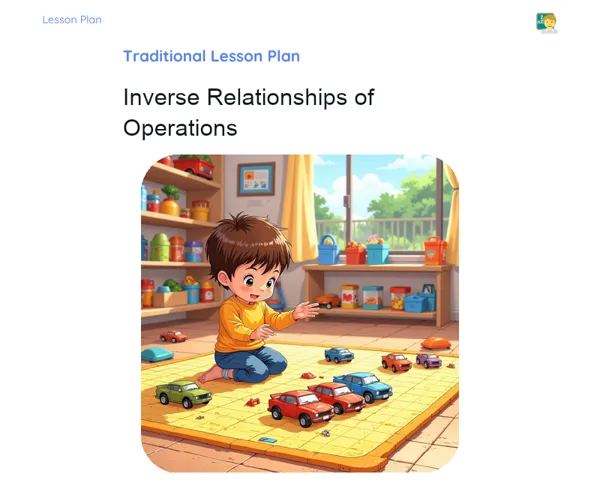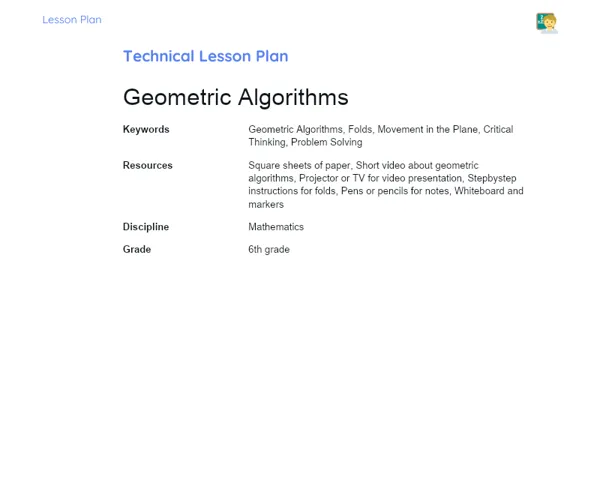Lesson Plan | Active Methodology | Comparison of Object Areas
| Keywords | Area Comparison, Visual Estimation, Practical Geometry, Interactive Activities, Group Work, Spatial Reasoning, Mathematical Application, Elementary Education, Problem Solving, Effective Communication |
| Necessary Materials | Cards with images of objects, Masking tape, Coloured paper in various shapes, Glue, Sufficient space for activities |
Premises: This Active Lesson Plan assumes: a 100-minute class duration, prior student study both with the Book and the beginning of Project development, and that only one activity (among the three suggested) will be chosen to be carried out during the class, as each activity is designed to take up a large part of the available time.
Objective
Duration: (5 - 10 minutes)
Establishing clear objectives is vital for a successful lesson. By defining what learners should achieve, they are guided towards the focus of their learning, and as educators, we can structure activities accordingly to meet these goals. This phase also serves to motivate learners by showing how the planned activities will aid in developing both their practical and cognitive skills.
Objective Utama:
1. Empower learners to visually compare the areas of different objects and identify which has a larger or smaller area.
2. Develop observational skills and spatial reasoning to estimate areas without needing exact measurements.
3. Encourage discussion and collaborative reasoning among learners as they compare their estimates and conclusions.
Objective Tambahan:
- Foster curiosity and interest in geometry and applied mathematics among learners.
- Promote the use of specific mathematical vocabulary in practical contexts.
Introduction
Duration: (15 - 20 minutes)
The introduction engages learners by inviting them to apply prior knowledge to new problem situations. It highlights the importance of comparing areas in real life, increasing interest in the topic and providing a practical context for the mathematical concepts being learned.
Problem-Based Situation
1. Imagine you’ve got two rugs: one rectangular and the other circular. Both need to cover certain areas in a room. How will you decide which rug to use without measuring their exact sizes?
2. You and your friends have different sized and shaped poster boards. You need to figure out which board has the biggest area to create a big poster for the science fair. How might you estimate this visually?
Contextualization
The ability to compare areas without exact measurements is crucial in daily life, from picking the right size tablecloth to deciding which picture frame will look best on a wall. Additionally, understanding these spatial relationships helps develop mathematical reasoning and is applicable in various professions like architecture, engineering, and design.
Development
Duration: (65 - 75 minutes)
This stage allows learners to engage practically with area estimation and comparison in an interactive manner. The proposed activities encourage teamwork, communication, and critical reasoning as they tackle playful and relevant challenges. This stage also reinforces learning, enabling learners to explore and reflect on the strategies they employed to estimate and compare areas.
Activity Suggestions
It is recommended that only one of the suggested activities be carried out
Activity 1 - Area Hunt
> Duration: (60 - 70 minutes)
- Objective: Develop estimation skills for areas while promoting collaboration and communication among learners.
- Description: In this fun activity, learners will be split into groups of up to 5. Each group will receive cards featuring images of objects of various shapes and sizes. Their task is to classify these objects according to their estimated areas, from smallest to largest. To add some excitement, each object will carry a score based on how challenging it is to accurately estimate its area.
- Instructions:
-
Divide the class into groups of up to 5 learners.
-
Hand out a set of cards displaying different objects to each group.
-
Challenge them to estimate and sort the objects according to their areas, from smallest to largest.
-
Each group will present their estimates and explain their reasoning to the class.
-
Discuss the diverse strategies each group used to estimate the areas.
Activity 2 - Shapes Festival
> Duration: (60 - 70 minutes)
- Objective: Enhance practical understanding of area and geometry while encouraging teamwork.
- Description: Learners will create large geometric shapes on the classroom floor or school yard using masking tape. Each group will be assigned a specific geometric figure to construct. After completing their figures, they will visually compare which one covers more area.
- Instructions:
-
Organise learners into groups and assign a geometric figure to each group.
-
Provide masking tape and ample space for constructing the figures.
-
Guide learners to build their figures accurately.
-
Once built, each group will explain how they constructed their figure and make a visual estimate of its area.
-
Hold a class discussion to compare the areas of the figures created.
Activity 3 - The Great Mosaic
> Duration: (60 - 70 minutes)
- Objective: Encourage creativity in problem-solving and demonstrate how different shapes can complement one another to cover areas.
- Description: In this activity, learners will create a mosaic on the classroom board using different shapes of coloured paper. The challenge will be to cover as much space as possible on the board, using their pieces creatively and efficiently.
- Instructions:
-
Divide the class into groups of up to five learners.
-
Distribute various geometric shapes of coloured paper and glue to each group.
-
Ask each group to plan and assemble a mosaic on the board, aiming to maximise area coverage.
-
Each group presents their mosaic and shares strategies they used to optimise coverage.
-
Conclude with a reflection on area estimation techniques and how different shapes can work together efficiently.
Feedback
Duration: (10 - 15 minutes)
The feedback stage provides learners with the opportunity to reflect on and articulate their learning through practical activities. By discussing their experiences and strategies, they develop a deeper understanding of area concepts and how estimates apply in real-world contexts. This discussion reinforces learning and fosters clear communication of mathematical ideas.
Group Discussion
To kick off the group discussion, the teacher can invite each group to share their findings and experiences from the activities. Encourage them to discuss how they estimated the areas and identify the strategies that worked best. Ask learners how they could use what they've learned in everyday scenarios.
Key Questions
1. What was the biggest challenge when estimating the areas of the objects?
2. How did the different shapes of the objects influence your estimates?
3. Do you think these area estimation techniques could come in handy outside the classroom? How?
Conclusion
Duration: (5 - 10 minutes)
The conclusion serves to reinforce what has been learned throughout the lesson, ensuring that learners can connect mathematical concepts to their actual applications. Summarising the main points reinforces acquired knowledge and highlights the relevance of studying mathematics in real-life situations, equipping learners to apply these concepts in their lives.
Summary
In wrapping up the lesson, it’s important to summarise and revisit the key concepts covered. Learners have learned how to visually compare the area of different objects and discussed methods for estimating these areas without precise measurements. The practical activities facilitated a direct application of this knowledge, reinforcing learning through tangible examples.
Theory Connection
Today's lesson bridged the gap between mathematical theory and its practical applications in learners' daily lives. Activities like 'Area Hunt' and 'Shapes Festival' showcased how valuable area concepts are in real-life situations, from organising spaces to creating art.
Closing
The ability to estimate and compare areas is fundamental not just within the academic sphere, but in various daily situations as well. From deciding on the right size rug to designing a poster, learners can recognise how mathematics is critical in addressing practical and everyday challenges.


